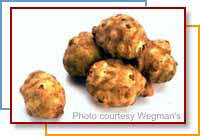Home | FOOD ARTICLES | Food Trivia | Today_in_Food_History | Food_History_Timeline | Recipes | Cooking_Tips | Food_Videos | Food_Quotes | Who’s_Who | Culinary_Schools_&_Tours | Food_Trivia_Quizzes | Food_Poems | Free_Magazines | Food_Festivals_and_Events
Food Articles, News & Features Section
You are here > Home > Food Articles >
FREE Magazines
and other Publications
Free Professional and Technical Research, White Papers, Case Studies, Magazines, and eBooks
Sunchoke or Jerusalem Artichoke
A relative of the sunflower, this vegetable is native to America, not Jerusalem, and has no botanical relation to artichokes. In fact, these tubers are actually a member of the Sunflower family. The white flesh is nutty, sweet and crunchy like chestnuts when raw. Baked in their skins, they become more like potatoes with a mild taste of artichoke hearts.
The Jerusalem artichoke is widely grown in gardens in Texas and is harvested in the fall for highest quality. Widely available in supermarkets, its peak period is September through January, but often continues through the early spring.
Select firm sunchokes that are firm and free from mold and wrinkles. Sunchokes vary in color where their shades range from dark brown to light brown in color, similar to ginger.

These tubers need be refrigerated, unwashed, in a plastic bag for up to 1 week for successful storage.
Nutrition
Serving Size 1 cup raw slices
Amounts Per Serving - % Daily Value *
Calories 110
Calories from Fat 0
Total Fat 0g - 0%
Sodium 5mg - 0%
Cholesterol 0mg - 0%
Total Carbohydrate 26g - 9%
Dietary Fiber 2g - 10%
Sugars 4g
Protein 3g
Vitamin A 0%
Vitamin C 10%
Calcium 2%
Iron 25%
* Percent Daily Values are based on a 2,000 calorie diet.
RELATED ARTICLES
Please feel free to link to any pages of FoodReference.com from your website.
For permission to use any of this content please E-mail: james@foodreference.com
All contents are copyright © 1990 - 2025 James T. Ehler and www.FoodReference.com unless otherwise noted. All rights reserved.
You may copy and use portions of this website for non-commercial, personal use only.
Any other use of these materials without prior written authorization is not very nice and violates the copyright.
Please take the time to request permission.
